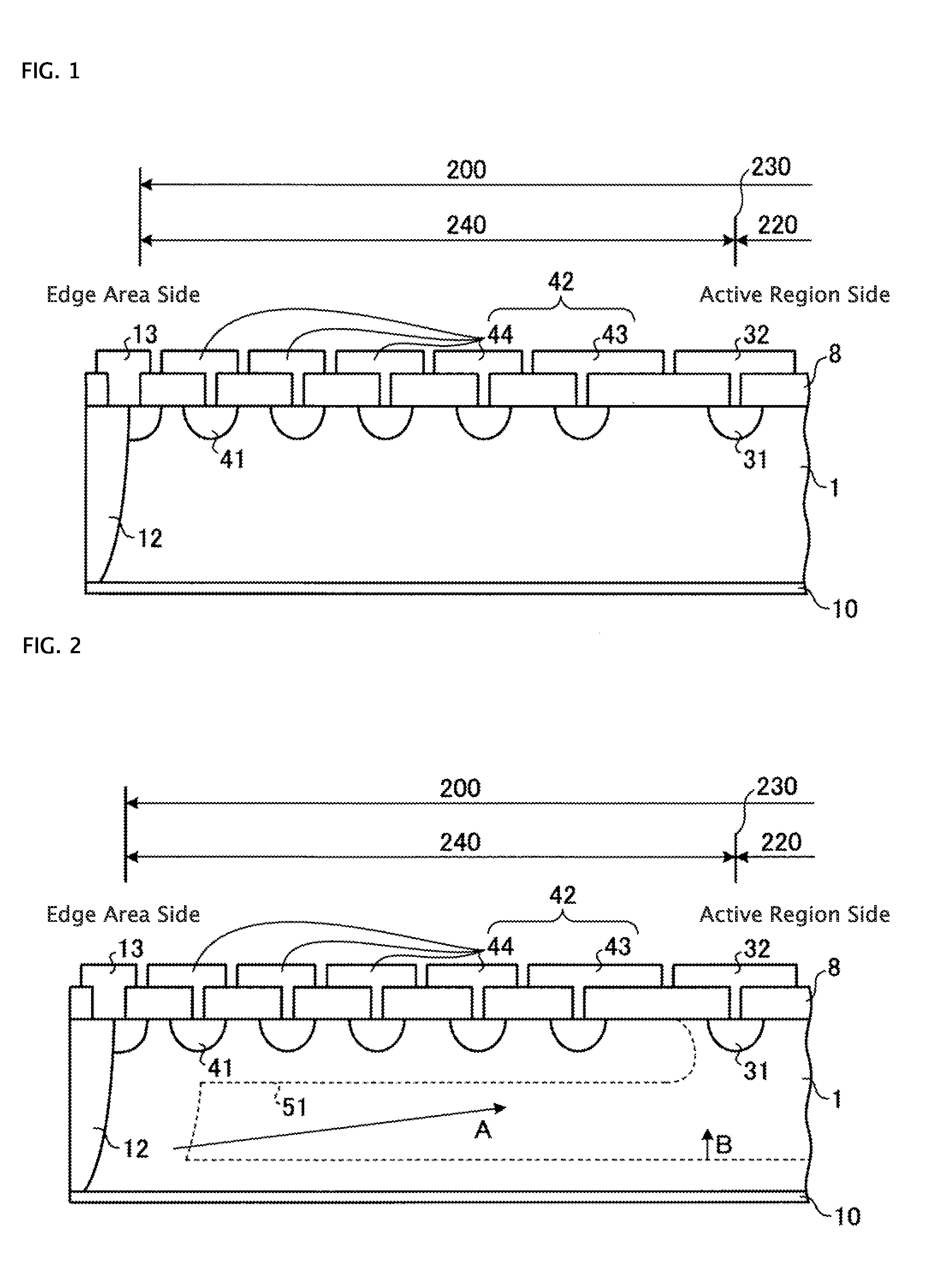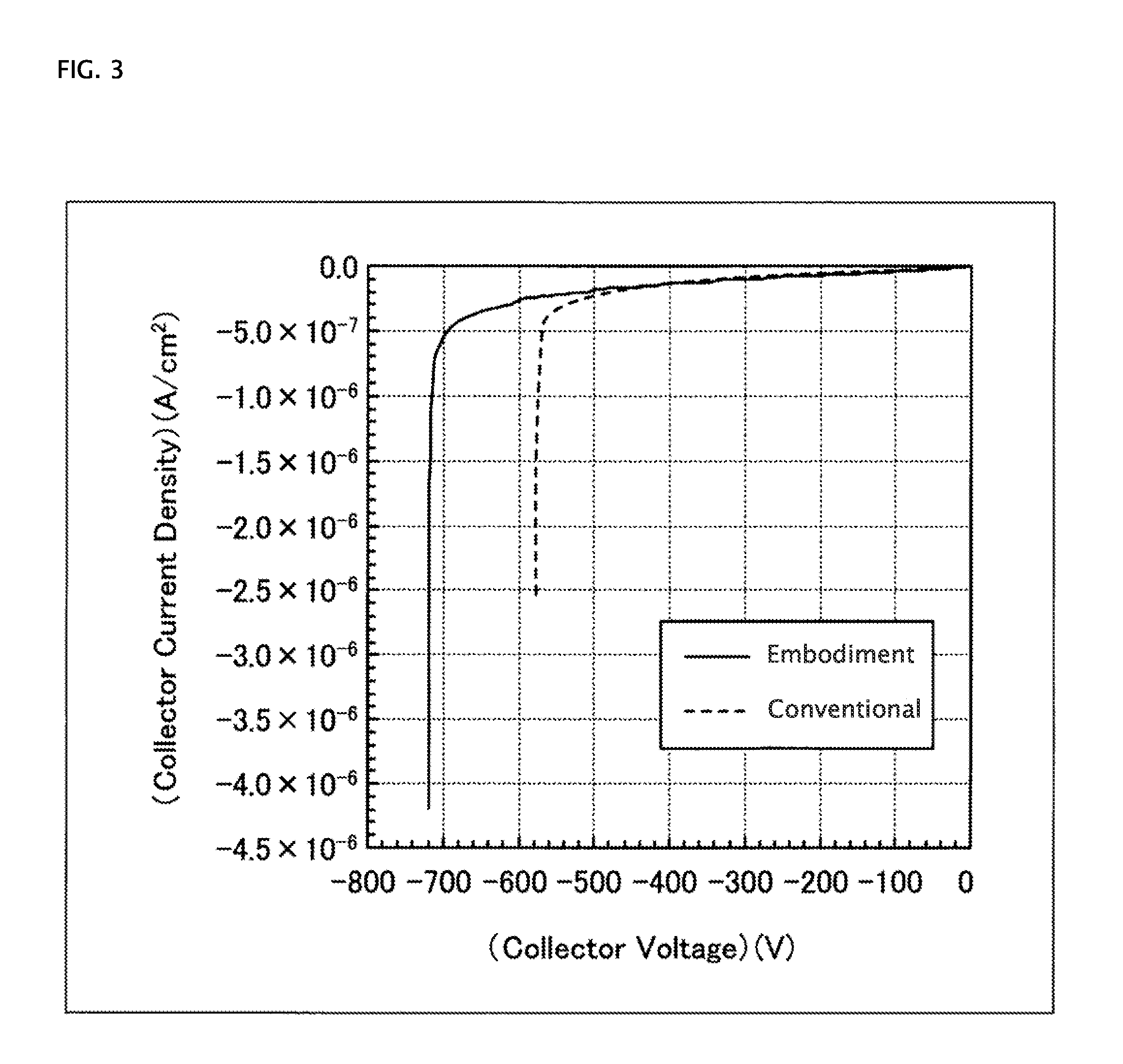Semiconductor device
- Summary
- Abstract
- Description
- Claims
- Application Information
AI Technical Summary
Benefits of technology
Problems solved by technology
Method used
Image
Examples
first embodiment
The reverse blocking insulated gate bipolar transistor (hereinafter referred to as the “reverse blocking IGBT”) according to a first embodiment of the invention includes a semiconductor substrate including an n-type (a first conductivity type) drift region; an active region in the semiconductor substrate; a breakdown-withstanding junction edge-termination region (hereinafter referred to simply as a “breakdown withstanding region”) outside the active region; and a p-type (a second conductivity type) separation region in the peripheral area of the breakdown withstanding region. In other words, the reverse blocking IGBT according to the first embodiment has a structure, in which the breakdown withstanding region is formed between an emitter region in the active region and the separation region. The breakdown withstanding region relaxes the electric field strength on a pn-junction constituting the semiconductor device and realizes a desired withstand voltages. The drift region correspon...
second embodiment
In the reverse blocking IGBT according to the first embodiment, a semiconductor substrate irradiated with an electron beam may be used. A thermal treatment may be conducted on the semiconductor substrate after the electron beam irradiation. The other structures are the same with the reverse blocking IGBT structures according to the first embodiment (cf. FIG. 1).
According to the second embodiment, an electron beam may be irradiated at the acceleration voltage of 4.8 MeV and at the dose of 20 kGy or higher to the semiconductor substrate used for manufacturing a reverse blocking IGBT. The electron beam irradiation may be conducted on the entire semiconductor substrate. By irradiating an electron beam to the entire semiconductor substrate, crystal defects (lattice defects) may be introduced intentionally into the semiconductor substrate. The thermal treatment after the electron beam irradiation may be conducted at 300 to 380° C. for around 1 hr. By conducting a thermal treatment after t...
third embodiment
FIG. 6 is a cross sectional view showing the breakdown-withstanding junction edge-termination region in a reverse blocking IGBT according to a third embodiment of the invention.
As shown in FIG. 6, the breakdown withstanding structure in the reverse breakdown withstanding region in the reverse blocking IGBT according to the first embodiment (cf. FIG. 1) may be applied to the forward breakdown withstanding region that obtains mainly a forward withstand voltage when a voltage is applied in the forward direction.
As shown in FIG. 6, forward breakdown withstanding region 220 is formed on the active region 100 side in breakdown-withstanding junction edge-termination region (hereinafter referred to simply as “breakdown withstanding region”) 200. More in detail, in breakdown withstanding region 200, forward breakdown withstanding region 220 is formed between active region 100 and middle section 230 of reverse breakdown withstanding region 240 and forward breakdown withstanding region 220. In...
PUM
 Login to View More
Login to View More Abstract
Description
Claims
Application Information
 Login to View More
Login to View More - R&D
- Intellectual Property
- Life Sciences
- Materials
- Tech Scout
- Unparalleled Data Quality
- Higher Quality Content
- 60% Fewer Hallucinations
Browse by: Latest US Patents, China's latest patents, Technical Efficacy Thesaurus, Application Domain, Technology Topic, Popular Technical Reports.
© 2025 PatSnap. All rights reserved.Legal|Privacy policy|Modern Slavery Act Transparency Statement|Sitemap|About US| Contact US: help@patsnap.com



